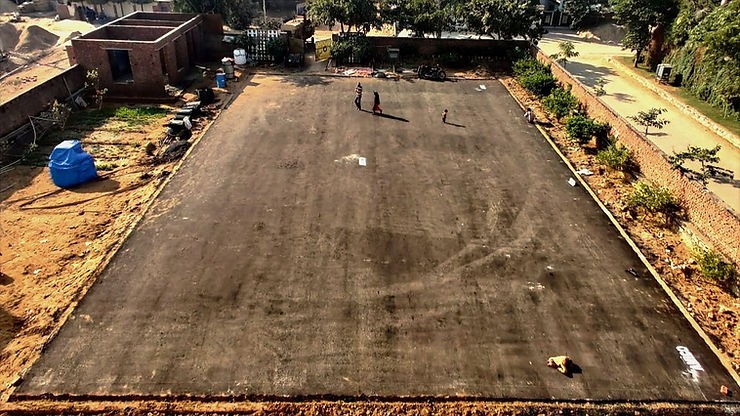Developing Asphalt Sports Base

To design the sports infrastructure, the developers or the planers have to go through various aspects while designing & constructing the grounds. These aspects are such,
- the type of sports to be played on the surface,
- the arrangement of lighting for proper luminous,
- the seating arrangements for the audience,
- proper entrance or exit from the grounds,
- kind of the synthetic sports to be used,
- planting trees or grasses nearby to maximize greenery (mostly in clubs),
- how to maximize the revenues by utilizing the available area efficiently, and many more.
All these key factors play an important role in designing sports surfaces efficiently. It can be noticed that all these factors can be classified as the visible factors, that is, they can be seen once the construction of the sports ground is done. Hence, this enables us to alter in the future if something doesn’t go as planned, such as the luminosity can be increased by increasing the number of lights, the seating arrangement can be altered, etc.
But there is one thing, which must go right in the very first place, i.e. The Sports Base. It can be referred to as the soul of any Sports Ground. The Sports base is the most underrated aspect of the sports infrastructure. Any kind of ill-planning in the Sports Base can result in ruining your ‘Costly’ Synthetic Surfaces.
This blog is mainly focused on the Sports Base for Acrylic Synthetic Grounds such as Lawn Tennis, Basketball, Volleyball, Pickleball, etc.
There exist two kinds of Sports bases, Reinforced Concrete Base & Asphalt Sports Base.
In this blog, we will stick to Asphalt Sports Base.
The Asphalt Sports Base is one of the most popular Sports base used widely all over the world. It is because of its various advantages over the Reinforced Concrete Base. At Amico Sports, almost 70-80% of clients ask us to construct Asphalt bases for their Synthetic Ground needs.
Excavation
The first and foremost step to develop any Sports Base is to excavate the existing base. It is important to remove any kind of trees, vegetation, wild-grass, roots from the base using excavating from the soil. Along with that, using Sterilising Agents to prevent the growth of any plantation in the future is also recommended.
After that, the compaction of the base should be done uniformly. This ensures that the base will hold its position for its lifetime (if done well). Because of the loose compaction, the cracks that develop in the base will be going to come upward and damage the Top Layer of Ground, i.e. Synthetic Surface.

Slope & Drainage
In the Asphalt Sports Base, it is recommended that on every ten feet there should be a slope of one inch. The slope must be carried from one side to another. Breaking the slope from the middle is not recommended. After the slope is planned, the perimeter drainage provision should be drafted. Slope in the drainage helps in letting the water flow towards the outlet.

Edge Wall (Retaining Wall)
Before pouring the aggregate on the base, the retaining brick wall is constructed on the periphery of the base, with a thickness of 9” and depth of 10”. The retaining wall, as the name suggests, helps in retaining or support the material such as aggregate and asphalt to be in place. The brick wall is then plastered with cement.
Water-Based Macadam
There exist two ways of developing the WBM based Asphalt Sports Base.
8” Base - First is, by using 2 layers of 3” WBM each.
6” Base - and another is using 1 Layer of 4” WBM.
Usage of an 8” base is recommended in very loose-soil conditions. Two layers of WBM helps in developing the strength in the base.
Generally, a 6” base is used as it is sufficient enough to provide desired strength to the base and also it is cost-effective.
The crushed aggregate is used to spread on the pre-compacted surface. The aggregate of 65 mm is spread uniformly all over the surface to achieve a thickness of 4 inches after the compaction. The aggregate is compacted by Steel Wheel Tandem Roller (8-10 tons). Water is sprayed at the time of rolling for greater compaction.

Tack coat
Before pouring Asphalt Surface Course, proper cleaning of the compacted base is recommended. It is done using Steel Brushes. The presence of any loose soil can affect the bonding of the Asphalt Course to the Aggregate Base, hence, all the loosened sand is thus removed from the surface. After that, the Diluted Emulsified Asphalt is applied as a Tack Coat on the base. This diluted asphalt works as a bonding agent between the Aggregate course and asphalt course.
Asphalt Surface Course
The aggregate of 15-20 mm mixed with hot asphalt is then poured to achieve the thickness of 30-35 mm. The asphalt mix is prepared on the Hot mix plant on site. After that, another layer of the aggregate of 6-10 mm mixed with hot asphalt is poured to achieve the thickness of 15-20 mm. The Asphalt Course is compacted by Steel Wheel Tandem Roller (8-10 tons) after every layer. And finally, the Seal-Coat sprinkled over the surface. Seal-Coat is a mixture of stone dust with hot asphalt. After the uniform compaction, the Asphalt Sports Base is now ready.

At Amico Sports, we understand how important it is to develop the Asphalt Sports Base properly. With the team of experienced professionals, we assure you to provide the best services when it comes to the construction of the Asphalt Sports Base for your sports ground needs.